May 20, 2025 | 15:37 GMT +7
May 20, 2025 | 15:37 GMT +7
Hotline: 0913.378.918
May 20, 2025 | 15:37 GMT +7
Hotline: 0913.378.918

Ninh Thuan is one of the provinces raising the most goats and sheep in our country. Photo: Mai Phuong.
In Ninh Thuan, extensive pastoral grasslands are diminishing. Ninh Thuan is a region with a sweltering and arid climate, with annual precipitation extending for only about three months. In addition, this region contains a vast natural grassland suitable for goat and sheep farming.
According to Mr. Phan Dinh Thinh, Director of the Livestock and Veterinary Sub-Department of Ninh Thuan, goats and sheep are simple to rear because their primary food source is vegetation and bushes. They can consume a variety of grasses, including cacti and other untamed plants. In addition, these animals are able to acclimate to a variety of terrains, from plains to rugged and mountainous regions, making extensive grazing simple. Likewise, diseases in goats and sheep are uncommon.
According to national statistics, Ninh Thuan is among the foremost provinces for goat and sheep husbandry. As of September 2023, the province's total goat population was 127,200, while the sheep population was 98,000. Compared to 2022, the number of goats and sheep has decreased by 7 to 9 percent.
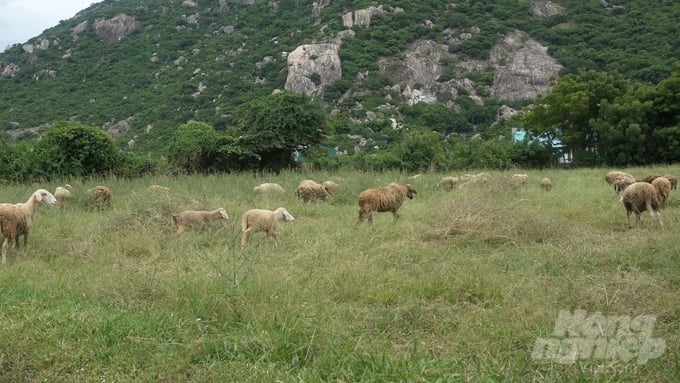
Currently, the majority of Ninh Thuan people raise goats and sheep using extensive semi-grazing methods. Photo: Phuong Chi.
In 2022, the output of goat flesh from the stable reached 2,206 tons, a 26% increase from 2018 and an average annual growth rate of 4.5%. Sheep production reached 2,009 tons in 2022, a 4% increase from 2018 and an average annual growth rate of 0.79 percent. This indicates that, despite the annual decline in total livestock size, annual flesh production is increasing.
Mr. Thinh asserts that the majority of livestock producers engage in open-range grazing. The primary dietary source is a combination of natural grasslands and agricultural byproducts such as straw, maize stalks, apple leaves, grape leaves, etc. Concentrations of goat and sheep husbandry are found in areas with forest land, hilly topography, and unused grazing land.
However, due to the expansion of agricultural land for energy and tourism initiatives, the province's natural grazing land has been reduced by an estimated 17,600 hectares. During the dry season, some grasslands perish, become arid, or cannot develop due to hot, dry weather and insufficient soil moisture, resulting in a lack of natural sustenance.
To ensure that goats and sheep have a reliable food source, livestock producers have invested in the cultivation of forage crops. People in the province have so far planted 1,200 hectares of forage crops to feed livestock such as goats and cattle. In addition, after harvesting, they store and process agricultural byproducts such as straw, chaff, cornstalks, and legumes into animal fodder for goats and sheep.
Goat and sheep husbandry in mountainous regions inhabited by ethnic minorities is typically small-scale, dispersed, and traditional. People here tend their livestock primarily on highland fields, in the shadow of forests, hills, and forested land. Generally, the practice of storing food is not followed.
In recent years, the prices of livestock products have barely risen and have fluctuated downwards. In addition, it is difficult to locate markets for livestock products, particularly for small-scale and independent livestock husbandry. Consequently, investors in livestock husbandry frequently incur losses.
According to the Provincial Livestock and Animal Health Sub-Department of Ninh Thuan, there are no livestock farming cooperatives in the province, and policies to support the development of livestock farming have not been implemented effectively at the local level. There are no prominent companies connecting goat and sheep producers with the market to establish a stable supply chain.
Due to a lack of capital and a lack of authentic cooperation among partners, value chain linkages in livestock husbandry have only reached a few livestock households or models, resulting in frequent contract violations. Investing in farms to connect with livestock companies, meanwhile, requires considerable land and infrastructure investments, which small-scale producers frequently lack the means to implement. This has hindered the development of the goat and sheep husbandry industry in Ninh Thuan.
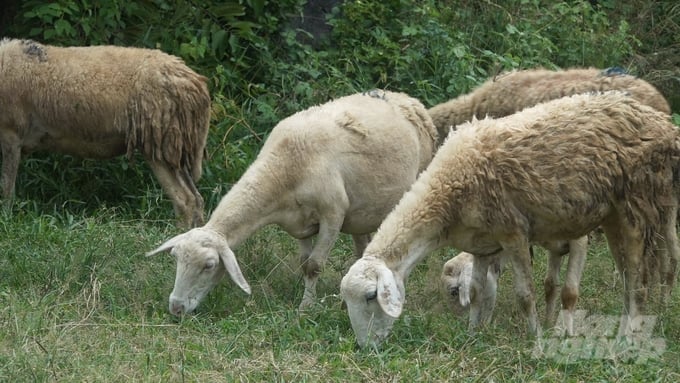
The majority of farming households in Ninh Thuan are mainly on a fragmented and small scale, causing low competitiveness and unstable output. Photo: Phuong Chi
According to Mr. Thinh, a number of our country's provinces have developed efficient goat husbandry, resulting in an abundance of goats. In addition, the global economy has been impacted by the post-Covid era, as protracted conflicts in a number of countries have led to a rise in oil prices, causing economic recession and global inflation, including in Vietnam. This, in turn, causes the price of livestock agricultural materials to increase while people's income decreases, resulting in a decline in the consumption of goat and sheep products.
According to the analysis of Mr. Le Ngoc Huong of Truong Tho village, Phuoc Hau commune, who owns two goat and sheep ranches with a total of approximately 500 animals, there is a shortage of goats and sheep in Vietnam. In recent years, the market prices of various livestock such as hogs and poultry have fluctuated, causing many producers in the province to operate at a loss. As a consequence, people have begun raising goats and sheep, resulting in an oversupply.
The vast majority of goat and sheep producers in Ninh Thuan are small-scale operations. This results in limited competitiveness and the continued need for goat and sheep flesh products to be sold through intermediaries, resulting in fluctuating prices and hardships for goat and sheep producers.
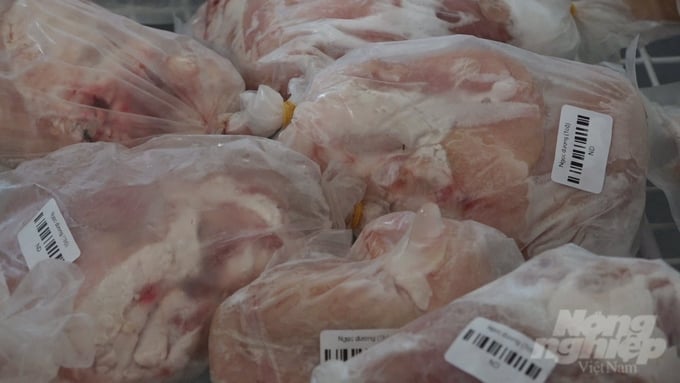
Goat and sheep products imported from abroad have lower prices than the domestic market, leading to many difficulties in consuming domestic products. Photo: Phuong Chi.
According to Mr. Huong, the cost of goats and livestock has been decreasing since March 2023. In comparison to the beginning of the year, traders now pay between 80,000 and 90,000 VND per kilogram. Previously, prices ranged from 110,000 to 120,000 VND per kilogram. At these prices, livestock producers cannot make a profit, and some are holding onto their herds in anticipation of a price increase.
According to Mr. Phan Dinh Thinh, despite that goats and sheep are specialty products of Ninh Thuan, goat and sheep producers in the province have encountered numerous difficulties and challenges in recent years.
One of the greatest obstacles for goat and sheep producers is the market for their products, which must compete with imported goat and sheep products that are less expensive than those on the domestic market. This has created consumption difficulties.
Translated by Linh Linh
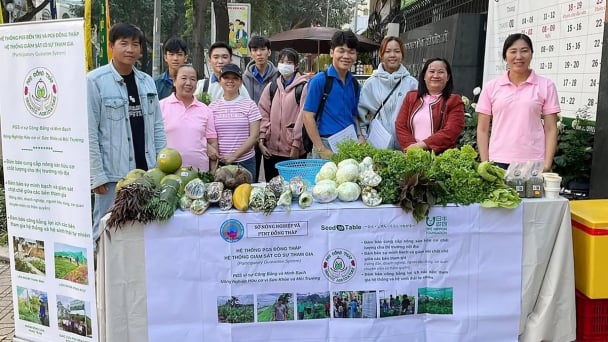
(VAN) Japan's grant aid project contributes to capacity building, promoting organic agricultural production, and fostering sustainable community development in Dong Thap province.

(VAN) For years, the CRISPR-Cas9 genome technology has been reshaping genetic engineering, a precision tool to transform everything from agriculture to medicine.
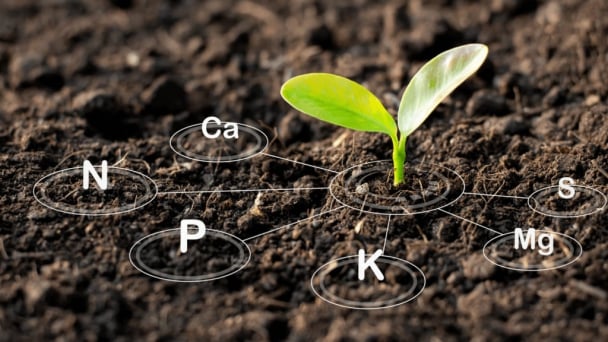
(VAN) Vietnam aims to become a 'leader' in the region in the capacity and managing effectively soil health and crop nutrition.
![Reducing emissions from rice fields: [Part 1] Farming clean rice together](https://t.ex-cdn.com/nongnghiepmoitruong.vn/608w/files/news/2025/05/05/z6509661417740_a647202949c539012a959e841c03e1d3-nongnghiep-143611.jpg)
(VAN) Growing clean rice helps reduce environmental pollution while increasing income, allowing farmers to feel secure in production and remain committed to their fields for the long term.
/2025/05/19/5136-1-144800_230.jpg)
(VAN) The Nghe An Provincial People's Committee has just approved the list of beneficiaries eligible for revenue from the Emission Reductions Payment Agreement (ERPA) in the North Central region for the year 2025.
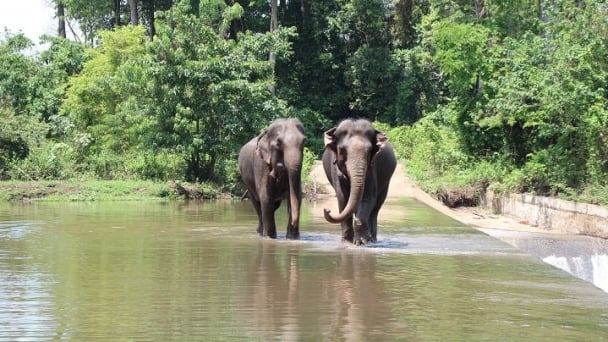
(VAN) 14 out of 35 domesticated elephants in Dak Lak province have had their living conditions improved, with 11 of them currently participating in the non-riding elephant tourism model.

(VAN) Muong Nhe Nature Reserve hopes that being upgraded to a national park will lay the foundation for forest protection efforts to be carried out in a systematic, modern, and sustainable manner.